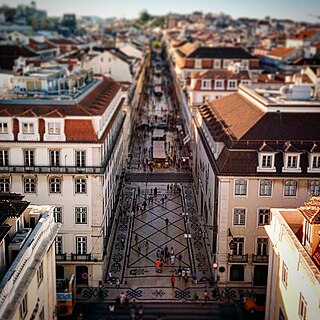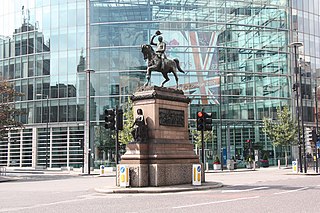Related Research Articles

The Great Plague of London, lasting from 1665 to 1666, was the last major epidemic of the bubonic plague to occur in England. It happened within the centuries-long Second Pandemic, a period of intermittent bubonic plague epidemics which originated from Central Asia in 1331, the first year of the Black Death, an outbreak which included other forms such as pneumonic plague, and lasted until 1750.
The history of London, the capital city of England and the United Kingdom, extends over 2000 years. In that time, it has become one of the world's most significant financial and cultural capital cities. It has withstood plague, devastating fire, civil war, aerial bombardment, terrorist attacks, and riots.

Piccadilly Circus is a road junction and public space of London's West End in the City of Westminster. It was built in 1819 to connect Regent Street with Piccadilly. In this context, a circus, from the Latin word meaning "circle", is a round open space at a street junction.
Edward Middleton Barry RA was an English architect of the 19th century.

The Monument to the Great Fire of London, more commonly known simply as the Monument, is a Doric column in London, England, situated near the northern end of London Bridge. Commemorating the Great Fire of London, it stands at the junction of Monument Street and Fish Street Hill, 202 feet (62 m) in height and 202 feet west of the spot in Pudding Lane where the Great Fire started on 2 September 1666. Constructed between 1671 and 1677, it was built on the site of St Margaret, New Fish Street, the first church to be destroyed by the Great Fire. It is Grade I listed and is a scheduled monument. Another monument, the Golden Boy of Pye Corner, marks the point near Smithfield where the fire was stopped.

Cheapside is a street in the City of London, the historic and modern financial centre of London, which forms part of the A40 London to Fishguard road. It links St. Martin's Le Grand with Poultry. Near its eastern end at Bank junction, where it becomes Poultry, is Mansion House, the Bank of England, and Bank station. To the west is St. Paul's Cathedral, St. Paul's tube station and square.
British Racing Partnership (BRP) was a racing team, and latterly constructor, from the United Kingdom. It was established by Alfred Moss and Ken Gregory – Stirling Moss's father and former manager, respectively – in 1957 to run cars for Stirling, when not under contract with other firms, along with other up-and-coming drivers.

The Baixa(Downtown), also known as the Baixa Pombalina is a neighborhood in the historic center of Lisbon, Portugal. It consists of the grid of streets north of the Praça do Comércio, roughly between the Cais do Sodré and the Alfama district beneath the Lisbon Castle, and extends northwards towards the Rossio and Figueira squares and the Avenida da Liberdade (Lisbon), a tree-lined boulevard noted for its tailoring shops and cafes.

The Great Fire of London was a major conflagration that swept through the central parts of London from Sunday, 2 September to Thursday, 6 September 1666. The fire gutted the medieval City of London inside the old Roman city wall. It threatened but did not reach the City of Westminster, Charles II's Palace of Whitehall, or most of the suburban slums. It destroyed 13,200 houses, 87 parish churches, St Paul's Cathedral, and most of the buildings of the City authorities. It is estimated to have destroyed the homes of 70,000 of the City's 80,000 inhabitants.

The Wood Street Compter was a small prison within the City of London in England. It was primarily a debtors' prison, and also held people accused of such misdemeanours as public drunkenness, although some wealthier prisoners were able to obtain alcohol through bribery. The prison was built and opened in 1555, replacing the earlier Bread Street Compter, from which many prisoners were transferred. Wood Street was closed and replaced by Giltspur Street Compter in 1791.
The Rebuilding of London Act 1666 is an Act of the Parliament of England with the long title "An Act for rebuilding the City of London." The Act was passed in February 1667 in the aftermath of the Great Fire of London and drawn up by Sir Matthew Hale. An earlier Act, the Fire of London Disputes Act 1666, had set up a court to settle disputes arising from buildings destroyed by the Fire. This Act regulated the rebuilding, authorized the City of London Corporation to reopen and widen roads, designated the anniversary of the Fire a feast day, and authorized the building of the Monument. A duty of one shilling on a chaldron of coal was imposed to pay for these measures.
The Rebuilding of London Act 1670 is an Act of the Parliament of England with the long title "Act for the rebuilding of the City of London, uniting of Parishes and rebuilding of the Cathedral and Parochial Churches within the said City." In 1666, a similar act had been passed in order to rebuild the City of London following the Great Fire. This particular Act extended the powers to enlarge streets and also ordered the rebuilding of St Paul's Cathedral.

St Benet Fink was a church and parish in the City of London located on what is now Threadneedle Street. Recorded since the 13th century, the church was destroyed in the Great Fire of London of 1666, then rebuilt to the designs of Sir Christopher Wren. The Wren church was demolished between 1841 and 1846.
This article covers the history of London during the Stuart period from 1603 to 1714.

St Mary Bothaw was a parish church in the Walbrook ward of the City of London. It was destroyed in the Great Fire of London in 1666 and not rebuilt, although some of its materials were used in the rebuilding of St Swithin, London Stone, whose parish it was merged with.

St Gabriel Fenchurch was a parish church in the Langbourn Ward of the City of London, destroyed in the Great Fire of London and not rebuilt.

Holborn Circus is a junction of five highways in the City of London, on the boundary between Holborn, Hatton Garden and Smithfield. It was designed by the engineer William Haywood and opened in 1867. The term circus describes the way the frontages of the buildings surrounding the junction curve round in a concave chamfer.

The Cranbrook Estate is a housing estate in Bethnal Green, London, England. It is located next to Roman Road and is based around a figure of eight street called Mace Street. The estate was designed by Francis Skinner, Douglas Bailey and an elder mentor, the Soviet émigré Berthold Lubetkin.

The Old Bell is a pub at 95 Fleet Street, London EC4.

Whitechapel Mount was a large artificial mound of disputed origin. A prominent landmark in 18th century London, it stood in the Whitechapel Road beside the newly constructed London Hospital, being not only older, but significantly taller. It was crossed by tracks, served as a scenic viewing-point, could be ascended by horses and carts, and supported some trees and formal dwelling-houses. It has been interpreted as: a defensive fortification in the English Civil War; a burial place for victims of the Great Plague; rubble from the Great Fire of London; and as a laystall. Possibly all of these theories are true to some extent.
References
- ↑ Cooper, Michael (2003), 'A More Beautiful City': Robert Hooke and the Rebuilding of London after the Great Fire, Sutton Publishing, ISBN 978-0-7509-2959-2